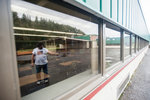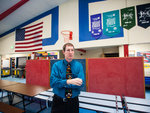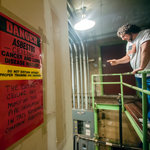





Editor’s Note: Today, The Chronicle begins a series looking at local school districts and the issues they face with aging infrastructure in the midst of an economy that has been slow to rebound. Two districts in our area, Toledo and Tenino, are bringing bonds to renovate schools before voters this year. To kick off our series, we take a look at the largest school district in Lewis County, Centralia.
If the walls of aging school facilities could talk, they would likely tell stories of the generations of children that have called them home. But as with every home in the Northwest, time and weather are never kind to what man has built.
Heather Slusher, the head custodian of Jefferson-Lincoln Elementary School on Summa Street in Centralia, has a job that has become increasingly difficult in recent years. Slusher isn’t just responsible for keeping the facility clean, but she and other school staff in recent years have had to figure out ways to keep the building in working condition while minimizing impacts to students.
The building, constructed in the 1950s and added onto as deemed necessary, is showing telltale signs of its age on a consistent basis, Slusher says. Recent problems have included roof leaks in more places than one, carpenter ants making their way into classrooms and old pipes turning water brown after extended breaks from school.
Staff have been able to quash each issue as it comes up — but those repairs end up costing time and money.
“A lot of times it just feels like we’re chasing problems,” Slusher said. “I get the feeling we’re on borrowed time with some of these buildings.”
Jefferson-Lincoln is home to about 450 students ranging from preschool to third grade. It’s just one of several schools that Centralia district officials say will need to be upgraded at some point. However, discussions on how to do so are coming — and the likely end game is that the school board will need to at some point approve running a bond.
Bonds are long-term financial commitments — generally with an option for 20 or 25 years — that generate money to rebuild, renovate or improve schools using tax dollars. Centralia School District Communications and Public Relations Coordinator Ed Petersen says the district has not had a bond on its rolls in several years.
“We’re going to have to run a bond at some point, but we just need to nail down for how long and for how much,” Petersen said.
Centralia school staff and administrators are celebrating a recent victory in the polls, as 61 percent of voters in the school district voted to renew the district’s maintenance and operations levy for the next four years. But asking for a new tax commitment from voters is a decision that will rest in the hands of the Centralia School Board, themselves members of the public who will have to hear from both sides of the issue — cash-strapped voters who don’t want another tax on their property versus those who would be willing to foot the bill.
The economy in Centralia shows signs of improvement, but one major issue is the continued tax devaluation of TransAlta property after it signed an agreement with the state to eliminate the use of coal in the next decade. That shifts the tax burden to other businesses and property owners in Centralia who are still required to maintain the same financial commitments approved by voters.
Back at Jefferson-Lincoln, Slusher worries people who don’t see the inside of the school often might not know about all the physical issues the school suffers from — in effect, not getting a full picture of what students and staff deal with on a daily basis.
“You can drive by and look at a house, and it looks good from the outside,” Slusher said, “but you have to look inside to get the story.”
If mounting small problems continue to affect Jefferson-Lincoln, its crosstown brother has been a poster child for large-scale damage through several flood events. Washington Elementary has been damaged by waters that inundated the school during flooding in 1972, 1990, 1996, 2007 and just last summer after a torrential downpour sent water cascading through the front door.
District maintenance and custodial staff have worked hard to build a flood wall solution that can be bolted onto vents and doorways, but that’s only a temporary fix — albeit one the district hopes can work well in the event of the next flood.
Washington lead custodian Rick Fink points to a large field behind the school as the point the water begins to pool and run off into the school. During a tour of the school Monday, Fink showed a Chronicle reporter and photographer the basement portion of the building — and sump pumps were already working to keep rainwater draining properly.
“This area is usually the first to get it pretty bad,” Fink explained.
Fink points to a number of upgrades performed at the school, showing the new fire enunciation and alarm system in the school’s office. But those upgrades can only help so much, Fink says, and the district will need to figure out a way to alleviate flood concerns at the school.
The two-decade district employee says it’s just a matter of time before his school needs a significant upgrade, the urgency of which has been sped up by nature’s hand as well as wear and tear on the property.
“I tell people to picture this: Can you imagine what happens if your house had people constantly going back and forth through it seven hours a day, five days a week?” Fink said. “Now multiply that by 400 kids. It’s going to wear out over time.”
•••
Christopher Brewer: (360) 807-8235 / Facebook: Chris Brewer - The Chronicle / Twitter: @iamchrisbrewer